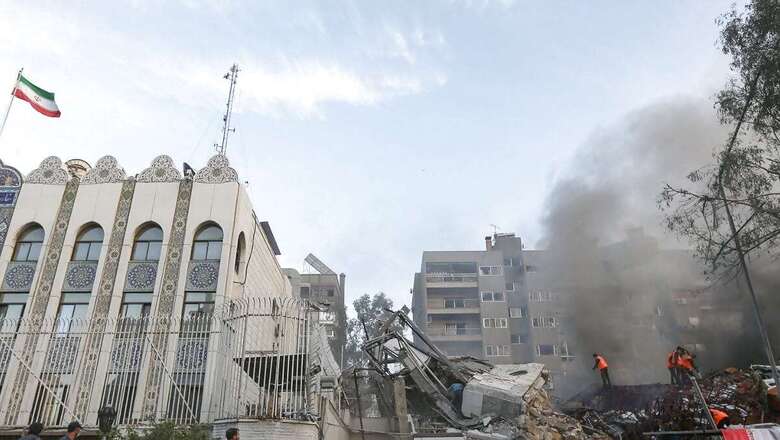
views
Israel this week launched two of the deadliest military strikes on the Iranian consulate in Damascus, increasing the frequency of Israeli-targeted killings on Iranian commanders. Seven members of the Islamic Revolutionary Guard Corps (IRGC) were killed including Brigadier General Mohammad Reza Zahedi, who was a key link between the IRGC and Hezbollah.
For Iran, Israel is a “cancerous tissue” in the Middle East and the biggest problem facing the Muslim world. Since the formative years of the Khomenie’s regime, Tehran has called for the destruction of Israel. In fact, they named the IRGC Army the Quds (“Jerusalem”) Force, meaning liberating “Jerusalem”.
Syria and Iran have coalesced into an alliance since the Islamic revolution of Iran in 1979 which saw Ayatollah Khomeni’s regime replacing a pro-Western Shah’s government in Tehran. The partnership between Damascus and Syria was strengthened when Hafez-al-Assad’s son Bashar-al-Ashad ascended to the throne in the 2000s. Both regimes are anti-Western and contemptuous of the US’ presence in the Middle East. The alliance began to develop in the context of the Iraq-Iran war in 1988. In 2004, the countries signed an agreement for strategic cooperation followed by a mutual defence pact in 2006.
Syria: Highway to Levant
Syria is a vital ally for realising Tehran’s regional aspirations. Iran seeks to overhaul the regional order by replacing the US’ presence from the Middle East. As Tehran is unsuccessful in combating the US and Israel in a conventional war, it deploys the strategy of countering its adversaries through proxy organisations. Over the years, Tehran has developed a network of proxies across the Middle East, called ‘axis of resistance’ to confront the US and Israel.
Syria has a geostrategic location in Tehran’s long-standing goals. Syrian territory provides Tehran access to its proxies like Hezbollah, PIJ and Hamas, allowing Tehran to transfer money, people and weapons. Iran has tremendously invested in Syria in terms of finance and human resources, which is an indication of the fact that Iran’s strategy in Syria is long-term. Syria has been Iran’s strategic partner in deterring Israel from attacking its proxies or attacking its nuclear program.
Augmenting Assad: IRGC Quds in Syria
Tehran’s strategy is to consolidate Bashar al-Assad’s grip on Syria and keep supporting Tehran in realising its stated goal of kicking out the US. Iran has stabilised Assad’s regime through its Quds forces. IRGC-QF as well as the Iranian Intelligence Service agencies have trained and advised Assad’s security and military services.
Iran began its military involvement in Syria in 2011 in the wake of the civil war. In 2016, Aleppo fell to the Quds Force achieving Iran’s immediate objective of saving Assad’s regime. After victory in the Battle of Aleppo, Iran began establishing permanent bases in Syria to house Quds Force personnel and foreign Shia militias under its command.
Iran’s strategy is to achieve a permanent military presence in Syria. So even if Assad’s regime falls in the wake of ongoing civil war, Tehran retains control over parts of Syria. The Iranian military facilities in Syria include general headquarters, regional command and control centres, intelligence cells, UAV battalions and runways, heavy equipment depots and other logistics facilities.
The second component of the strategy is to consolidate the pro-government Shia militias in Syria. The Quds Force has launched a campaign dubbed as ‘Precision Project’ to upgrade the rockets and missile arsenals of the Shia militias, particularly Lebanese Hezbollah.
The extent of IRGC-QF involvement in Syria became clear in February 2013 when Iranian Brigadier General Hassan Shateri was assassinated in the Damascus countryside while travelling to Beirut. The presence of such a high-ranking commander inside Syria highlights Tehran’s commitment to achieving its objectives in the country, as well as its potential vulnerabilities, should Assad fall.
The US military back in 2020 killed IRGC-QF Major General Qasem Soleimani in a targeted drone strike in Baghdad. Former Syrian Prime Minister Riad Hijab said in a news conference after his defection that “Syria is occupied by the Iranian regime. The person who runs the country is not Bashar al-Assad but Qasem Soleimani, the head of Iranian regime’s Quds Force”.
Israeli Response: Campaign between the wars
On September 7, 2017, Israeli fighter jets hit a “scientific research centre” (in reality, an Iranian weapons facility) in the city of Masyaf in Syria, marking the next phase of the “campaign between the wars” (known in Hebrew as m’aracha bein ha-milchamot or by the acronym mabam). Israeli military activity called ‘Operation Chess’ was limited to targeting Iranian facilities in Syria as well as its proxies like Hezbollah.
Typically Israel has refrained from “high-value” targeted killings of Iranian liaison officers alone. But several new trends indicate a strategic shift in the Israeli approach to countering Iran in Syria to secure its northern border. Israelis are now more upfront than before in the offensive against the Quds Force in Syria. Israel on December 25, 2023, killed Iranian military officer Sayyed Razi Mousavi, south of Damascus in an airstrike. At the time of his death, Mousavi was described as Iran’s most influential military commander in Syria. In fact, over the past six months, 18 members of the Quds Force have been killed.
The author writes on international affairs. Views expressed in the above piece are personal and solely those of the author. They do not necessarily reflect News18’s views.

















Comments
0 comment